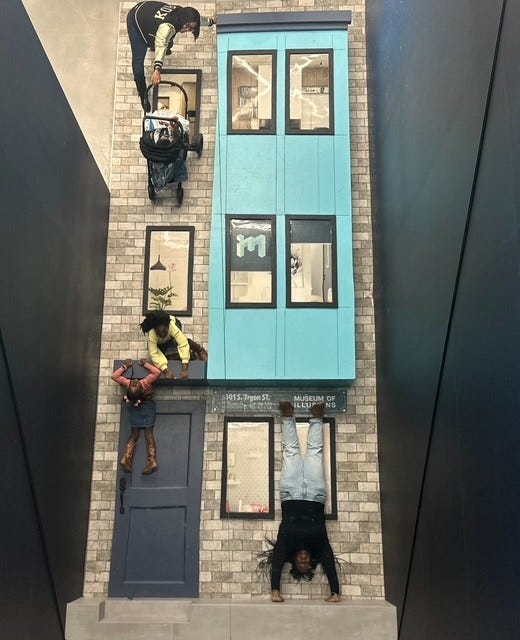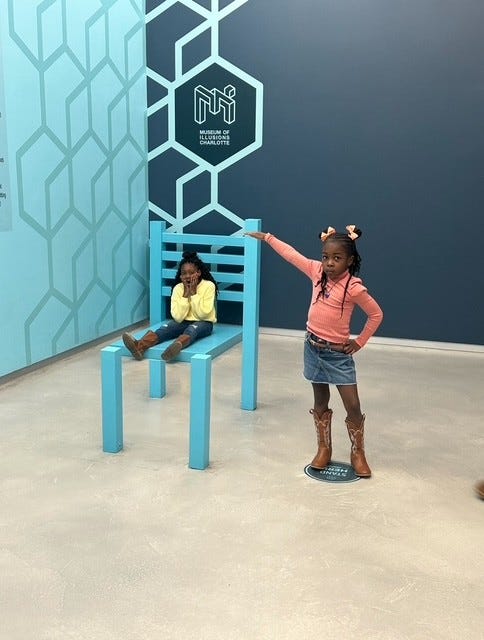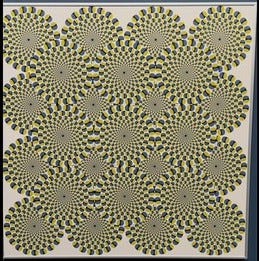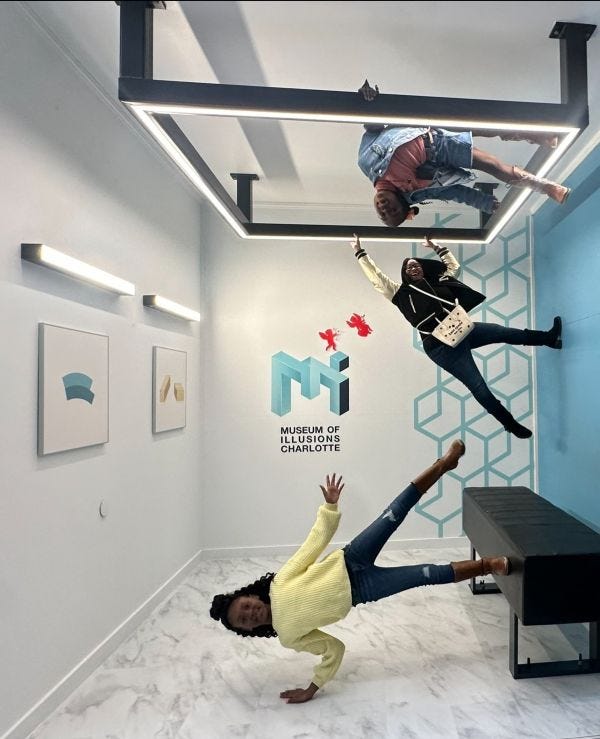This is an Eval Central archive copy, find the original at medium.com/innovationnetwork.
By Shelli Golson-Mickens, Innovation Network Senior Associate
Our team at Innovation Network spends the first week of each year engaging in independent study. During this week, we engage in activities that inspire and reinvigorate us to continue our social impact work. Seeking inspiration, I visited the Museum of Illusions in Charlotte, NC — a place where reality is playfully distorted, and every exhibit invites us to see things from a fresh perspective. I explored the space with my good friend and our daughters, and the experience offered more than just visual delight. For me, it unexpectedly sparked a reflection on how our varied perceptions, whether fully accurate or not, are the building blocks for narratives that can support or harm communities.
The Power of Perception
The museum is filled with cleverly designed exhibits that manipulate light, shadow, and space, causing us to reconsider what we think we know about our surroundings. Each illusion reminded me that our perceptions are personal, fluid, and influenced by our individual viewpoints. As a parallel, I considered how perspectives are shaped in our society. They are just as fluid as the exhibits at the museum, and they (our perceptions) are used to create powerful narratives — stories that shape our communities, the way we connect with each other, and our drive to serve each other.
Perception as a Narrative Tool in Today’s Political Landscape
In today’s complex world, the narratives we create from our perceptions — real or imagined — play a significant role in how we view ourselves and our communities. In the museum, my daughter’s wonder at a seemingly shifting exhibit, a static image that appeared to rotate continuously, wasn’t just childlike awe; it was an expression of her current perspective, her brain’s reception of visual information producing a “real” experience. Similarly, every individual’s way of seeing the world contributes to a larger, collective story, or perceived reality, that can either divide or unite us.
Right now, the dividing perception is dominating. Many are investing in the narrative that dismantling initiatives to promote equity and inclusion will lead to a more productive society. Much evidence disproves this ideology, but the prevailing perception is palpable and all but eliminates the line between reality and fallacy. Challenging this narrative will involve more than vocal resistance; it requires that we work to shift these harmful perspectives. If we only express disagreement without working to change the narrative, our collective exasperation will accumulate in a void, only to be heard by those who agree with us. If we use our words while working to change perspectives, then new narratives can be built — inclusive narratives that elevate all communities.
Changing Perspectives to Support a Unified Society
With these reflections, I am considering the way that my work can support shifting perspectives in support of equitable societies. In a climate where every political stance is underpinned by personal perceptions and is integrated into our identities, I am now considering what I can do to help shift those perceptions and change the current narratives that are moving us back in time. I did not leave the museum with explicit steps to achieve such a lofty goal, but I have a renewed purpose and some guidelines to frame my exploration:
(1) Perceptions are not reality, but they build narratives that have real consequences. Considering how powerful our perceptions are, changing political perspectives cannot be considered optional. These actions are imperative to continue progressing toward an equitable and inclusive society.
(2) Harnessing the power of varied narratives means looking beyond disagreements, when we can, and engaging with the stories that drive political behavior. By understanding these underlying perspectives, we can begin the work to reshape them.
(3) Equity and inclusion work must continue, but we will have to shift the way that we engage in this work. While the need is clear, new approaches are yet to be determined. The time has arrived to rethink the way that we engage in equity work to ensure that it continues despite current attacks.
With these guidelines to frame my thinking, I seek to discover ways to harness perceptions and work to shift them in a more unified direction.
An Invitation for Reflection and Engagement
My visit to the Museum of Illusions was more than a whimsical adventure; it was a catalyst for recognizing the value of every perception in shaping our shared narrative. The playful and seemingly simple distortions in the museum reminded me that even altered realities can spark new ways of thinking. In a similar way, when we shift different perceptions into our collective story, we empower communities to challenge outdated assumptions and build more just and supportive environments.
That said, this is not a formal call to action in the traditional sense. Advocacy, particularly in the face of sustained political resistance, is demanding work — work that not everyone is always able, or willing, to undertake at every moment. The expectation that individuals must persistently defend their right to exist and be valued is itself an undue burden. Rest is necessary, and disengagement, at times, is both valid and strategic.
However, while this is not a directive for immediate action, it is an invitation for reflection and engagement. Narratives shape policy, culture, and community, and whether we acknowledge it or not, we are always contributing to the stories that define our society. If this viewpoint resonates, then perhaps that resonance is a call to join me as I continue to build narratives that harness the power of perception to uplift communities and drive meaningful equity and inclusion efforts.





Beyond Illusions: Recognizing the Need to Harness Perception to Build Inclusive Narratives was originally published in InnovationNetwork on Medium, where people are continuing the conversation by highlighting and responding to this story.